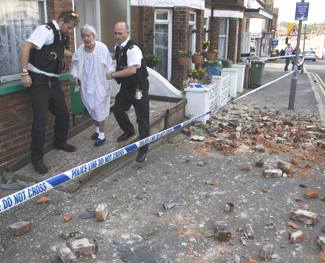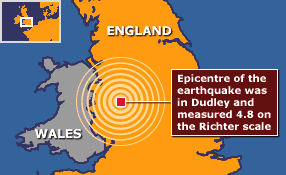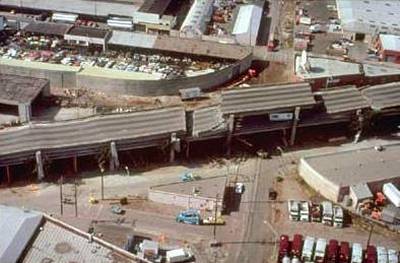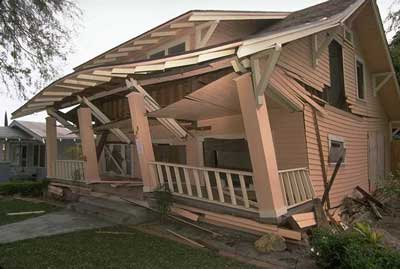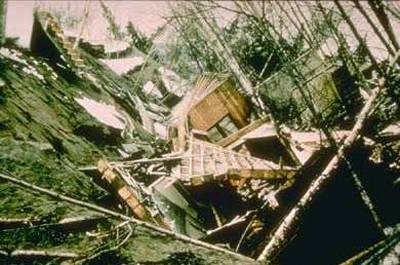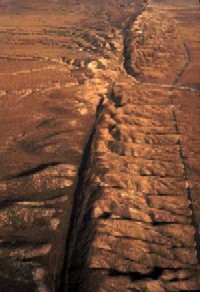|
EARTHQUAKES
|
|
HOME | BIOLOGY | FILMS | GEOGRAPHY | HISTORY | INDEX | INVESTORS | MUSIC | NEWS | SOLAR BOATS | SPORT |
|
Telegraph News - Earthquake hits UK - 27 February 2008
An earthquake was felt across large parts of England in the early hours of this morning. Tremors were felt in areas including Merseyside, Birmingham, Leicestershire, Bedfordshire, Northampton, Norfolk, Surrey and Greater London.
There were no initial reports of damage from the five-second tremor, which is believed to have struck at 00.55am. The epicentre is believed to have been 15 miles north of Lincoln and initial reports suggest it reached 4.7 on the Richter scale.
Ian Gilmore, 63 from Rainford near St Helens on Merseyside was watching a film when he felt the tremor. His wife Patricia was also woken up and rushed downstairs to see what had happened. Mr Gilmore said: "It was incredible - I have never felt anything like it."
A resident in Norfolk described it as "a real mover and shaker". She said: "It was like a big juggernaut coming down the road. The whole house shook - it was a real bone shaker"
Other witnesses reported to Sky News that wildlife - birds and pets - became highly agitated as the ground shook. The West Midlands was hit by an earthquake in 2002 in the Dudley area that reached 5.0 on the Richter scale and caused damage to homes.
ORIGIN TIME: 00:56 46.6s UTC LAT/LON: 53.419º North / 0.354º East GRID REF: 509.4 kmE / 392.6 kmN DEPTH: 1.8 km MAGNITUDE: 5.2 ML LOCALITY: Market Rasen, Lincolnshire INTENSITY: 6 EMS
Map showing earthquake Folkestone, Kent, 2007
UK earthquakes (Richter scale measurements)
6.1 biggest ever recorded, about 120km off Great Yarmouth, June 1931 5.4 biggest on land in Lleyn, north Wales, July 1984 5.1 in Bishop's Castle, Shropshire, in 1990 4.2 in Warwick, Sept 2000 4.1 shook Melton Mowbray, Leicestershire, Oct 2001 5.0 - Dudley, West Midlands, September 2002 3.5 - Dumfries and Galloway, December 2006 4.7 - Midlands and Greater London, February 2008
Monday, 23 September, 2002, 09:53 GMT 10:53 UK - Earthquake hits UK
The tremors began at approximately 0054 BST, the epicentre was in Dudley in the West Midlands. Large parts of England and Wales have been hit by an earthquake measuring 4.8 on the Richter scale.
Buildings
shook for up to 30 seconds in parts of the West Midlands, Wales, North
Yorkshire, London, and Wiltshire.
There was minor
structural damage as homes were shaken, but no reports of any injuries.
Aftershocks were felt later on
Monday morning from what is thought to be the UK's largest earthquake for
10 years.
Glenn
Ford, a senior seismologist at the British Geological Survey (BGS), said:
"It's an extremely large earthquake in UK terms but not large in
world terms; we'd only classify it as a light earthquake." BBC
weather forecaster Pete Gibbs said: "It's not that unusual to have an
earth tremor, but it is unusual to be that widespread and that widely
reported. "However, earth tremors are certainly not that uncommon in
the UK."
West
Midlands Police said they had 5,000 calls to their switchboard within an
hour of the tremor happening and 600 calls to the 999 number. Dudley
police said 12 people in nightclothes walked into their local police
station.
Sudden shocks
Julian
Bukits, of the BGS, said an earthquake of magnitude four is equivalent to
1,000 tonnes of TNT - that in turn is equivalent to the power of a small
nuclear weapon. The BGS said the earthquake's epicentre could only be
located to within about a kilometre, and not pinpointed to an exact street
or address. Dr David Kerridge, senior seismologist, said:
"Aftershocks are a possibility but we wouldn't expect anything of the
same magnitude."
Although
Monday's earthquake was large by British standards, tremors in places like
California, Japan and India can reach seven or more on the Richter scale.
The whole length of Wales was shaken and
people over 120 miles (190 km) apart felt two sudden shocks.
Earthquake UK, Kent, 2007
'Frightening'
experience
In
south Wales, people in Cardiff, Newport, Caerphilly, the Vale of Glamorgan
and as far west as Swansea, felt the powerful shocks.
Callers to the BBC reported doors slamming and windows rattling.
Many
miles further north, in Wrexham, officers from North Wales Police said
their control room in a tower block shook violently.
Richard
Flynn, from Oldbury in the West Midlands, said: "The house started
shaking quite violently at about 1am. All the power was cut off and seemed
to be so for about a five-mile (8-km) radius.
"The
shaking and trembling was really quite severe. Quite a few people came out
of their houses wondering what was going on. The streets were in
darkness."
Power
was restored after about 20 minutes.
Ground
swayed
One
Birmingham resident, Alex Potter, told BBC Radio Five Live: "My first
thought was it's a bomb and then an earthquake.
"There was an earthquake in Birmingham back in the fifties when I was a boy but back then the ground swayed. It was quite different this time."
He
added: "It was really quite frightening. I'm convinced there were two
booms - lasting five or six seconds each."
Bill
Wilson, who was duty inspector for Merseyside Police at the time of the
tremor, said he took up to 30 calls from people who initially thought
there was an intruder in their home or there had been an explosion.
"I've
never had to take calls like this and some people I rang up myself thought
I was winding them up but I had to assure them that I was serious."
Between
200 and 300 quakes occur in Britain each year, but only about 10% are
strong enough to be felt.
Buildings are deemed to be at risk from a quake over 5 on the Richter scale, according to the Environment Agency.
World's worst recorded quakes
9.5 Chile 1960, killed 2,000 8.3 California 1906, killed 3,000 8.3 China 1976, killed 240,000 7.9 India 2001, killed 25,000
Description
An earthquake is one of the most terrifying phenomena that nature can dish up. We generally think of the ground we stand on as "rock-solid" and completely stable. An earthquake can shatter that perception instantly, and often with extreme violence.
Up until relatively recently, scientists only had unsubstantiated guesses as to what actually caused earthquakes. Even today there is still a certain amount of mystery surrounding them, but scientists have a much clearer understanding.
7.1 quake that shook San Francisco area in 1989 Photo courtesy USGS
There has been enormous progress in the past century: Scientists have identified the forces that cause earthquakes, and developed technology that can tell us an earthquake's magnitude and origin. The next hurdle is to find a way of predicting earthquakes, so they don't catch people by surprise.
Basically, an earthquake is a vibration that travels through the earth's crust. Technically, a large truck that rumbles down the street is causing a mini-earthquake, if you feel your house shaking as it goes by, but we tend to think of earthquakes as events that affect a fairly large area, such as an entire city.
All kinds of things can cause earthquakes:
But the majority of naturally-occuring earthquakes are caused by movements of the earth's plates.
We only hear about earthquakes in the news every once in a while, but they are actually an everyday occurrence on our planet. According to the United States Geological Survey, more than three million earthquakes occur every year. That's about 8,000 a day, or one every 11 seconds!
Photo courtesy FEMA
The vast majority of these 3 million quakes are extremely weak. The law of probability also causes a good number of stronger quakes to happen in uninhabited places where no one feels them. It is the big quakes that occur in highly populated areas that get our attention.
Earthquakes have caused a great deal of property damage over the years, and they have claimed many lives. In the last hundred years alone, there have been more than 1.5 million earthquake-related fatalities. Usually, it's not the shaking ground itself that claims lives -- it's the associated destruction of manmade structures and the instigation of other natural disasters, such as tsunamis, avalanches and landslides.
Prince William Sound, Alaska, damage caused by a 1964 9.2 earthquake Photo NGDC
SLIDING
PLATES The biggest scientific breakthrough in the history of seismology - the study of earthquakes - came in the middle of the 20th century, with the development of the theory of plate tectonics. Scientists proposed the idea of plate tectonics to explain a number of peculiar phenomenon on earth, such as the apparent movement of continents over time, the clustering of volcanic activity in certain areas and the presence of huge ridges at the bottom of the ocean.
The basic theory is that the surface layer of the earth - the lithosphere - is comprised of many plates that slide over the lubricating athenosphere layer. At the boundaries between these huge plates of soil and rock, three different things can happen:
The San Andreas fault California, which marks the plate boundary between the Pacific oceanic plate and the North American continental plate, extends over 650 miles (1,050 km) of land Photo courtesy USGS
Where these plates meet, you'll find faults -- breaks in the earth's crust where the blocks of rock on each side are moving in different directions. Earthquakes are much more common along fault lines than they are anywhere else on the planet. Hence, along these fault lines we can expect to see most serious earthquakes.
LINKS and REFERENCE
http://www.telegraph.co.uk/news/main/news/2008/02/27/quake
Solar Cola drinkers care about climate chaos ...
.. Thirst for Life
330ml Earth can - the World in Your Hands
|
|
This
website
is Copyright © 1999 & 2008 NJK. The bird The name '1824' is a trade mark of Solar Cola Ltd. All rights reserved. Max Energy Limited is an educational charity. |
|
AUTOMOTIVE | BLUEBIRD | ELECTRIC CARS | ELECTRIC CYCLES | SOLAR CARS |

